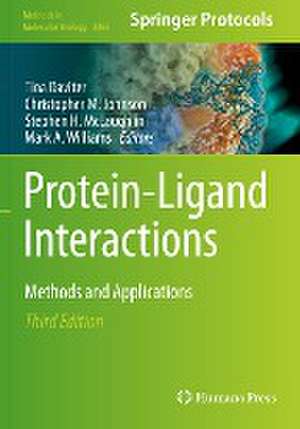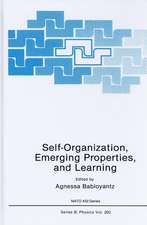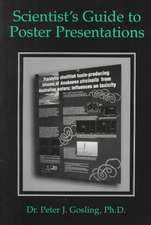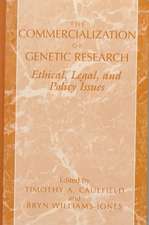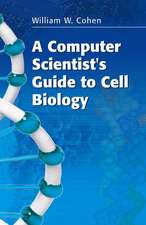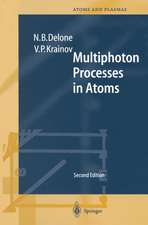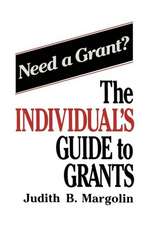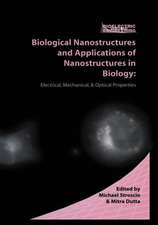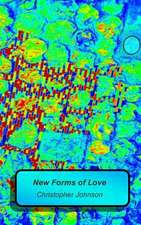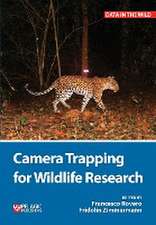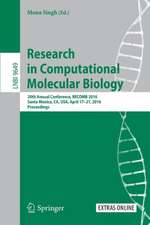Protein-Ligand Interactions: Methods and Applications: Methods in Molecular Biology, cartea 2263
Editat de Tina Daviter, Christopher M. Johnson, Stephen H. McLaughlin, Mark A. Williamsen Limba Engleză Paperback – 21 apr 2021
Authoritative and accessible, Protein Ligand Interactions: Methods and Applications, Third Edition serves as an ideal guide for researchers new to the field of biophysical characterization of protein interactions.
| Toate formatele și edițiile | Preț | Express |
|---|---|---|
| Paperback (1) | 845.83 lei 6-8 săpt. | |
| Springer Us – 21 apr 2021 | 845.83 lei 6-8 săpt. | |
| Hardback (1) | 1238.56 lei 6-8 săpt. | |
| Springer Us – 21 apr 2021 | 1238.56 lei 6-8 săpt. |
Din seria Methods in Molecular Biology
- 9%
 Preț: 791.63 lei
Preț: 791.63 lei - 23%
 Preț: 598.58 lei
Preț: 598.58 lei - 20%
 Preț: 882.98 lei
Preț: 882.98 lei -
 Preț: 252.05 lei
Preț: 252.05 lei - 5%
 Preț: 802.70 lei
Preț: 802.70 lei - 5%
 Preț: 729.61 lei
Preț: 729.61 lei - 5%
 Preț: 731.43 lei
Preț: 731.43 lei - 5%
 Preț: 741.30 lei
Preț: 741.30 lei - 5%
 Preț: 747.16 lei
Preț: 747.16 lei - 15%
 Preț: 663.45 lei
Preț: 663.45 lei - 18%
 Preț: 1025.34 lei
Preț: 1025.34 lei - 5%
 Preț: 734.57 lei
Preț: 734.57 lei - 18%
 Preț: 914.20 lei
Preț: 914.20 lei - 15%
 Preț: 664.61 lei
Preț: 664.61 lei - 15%
 Preț: 654.12 lei
Preț: 654.12 lei - 18%
 Preț: 1414.74 lei
Preț: 1414.74 lei - 5%
 Preț: 742.60 lei
Preț: 742.60 lei - 20%
 Preț: 821.65 lei
Preț: 821.65 lei - 18%
 Preț: 972.30 lei
Preț: 972.30 lei - 15%
 Preț: 660.49 lei
Preț: 660.49 lei - 5%
 Preț: 738.41 lei
Preț: 738.41 lei - 18%
 Preț: 984.92 lei
Preț: 984.92 lei - 5%
 Preț: 733.29 lei
Preț: 733.29 lei -
 Preț: 392.60 lei
Preț: 392.60 lei - 5%
 Preț: 746.26 lei
Preț: 746.26 lei - 18%
 Preț: 962.66 lei
Preț: 962.66 lei - 23%
 Preț: 860.22 lei
Preț: 860.22 lei - 15%
 Preț: 652.64 lei
Preț: 652.64 lei - 5%
 Preț: 1055.50 lei
Preț: 1055.50 lei - 23%
 Preț: 883.87 lei
Preț: 883.87 lei - 19%
 Preț: 491.89 lei
Preț: 491.89 lei - 5%
 Preț: 1038.86 lei
Preț: 1038.86 lei - 5%
 Preț: 524.16 lei
Preț: 524.16 lei - 18%
 Preț: 2122.34 lei
Preț: 2122.34 lei - 5%
 Preț: 1299.23 lei
Preț: 1299.23 lei - 5%
 Preț: 1339.12 lei
Preț: 1339.12 lei - 18%
 Preț: 1390.26 lei
Preț: 1390.26 lei - 18%
 Preț: 1395.63 lei
Preț: 1395.63 lei - 18%
 Preț: 1129.65 lei
Preț: 1129.65 lei - 18%
 Preț: 1408.26 lei
Preț: 1408.26 lei - 18%
 Preț: 1124.92 lei
Preț: 1124.92 lei - 18%
 Preț: 966.27 lei
Preț: 966.27 lei - 5%
 Preț: 1299.99 lei
Preț: 1299.99 lei - 5%
 Preț: 1108.51 lei
Preț: 1108.51 lei - 5%
 Preț: 983.76 lei
Preț: 983.76 lei - 5%
 Preț: 728.16 lei
Preț: 728.16 lei - 18%
 Preț: 1118.62 lei
Preț: 1118.62 lei - 18%
 Preț: 955.25 lei
Preț: 955.25 lei - 5%
 Preț: 1035.62 lei
Preț: 1035.62 lei - 18%
 Preț: 1400.35 lei
Preț: 1400.35 lei
Preț: 845.83 lei
Preț vechi: 1031.50 lei
-18% Nou
Puncte Express: 1269
Preț estimativ în valută:
161.90€ • 175.92$ • 136.08£
161.90€ • 175.92$ • 136.08£
Carte tipărită la comandă
Livrare economică 21 aprilie-05 mai
Preluare comenzi: 021 569.72.76
Specificații
ISBN-13: 9781071611999
ISBN-10: 1071611992
Ilustrații: XI, 492 p. 123 illus., 80 illus. in color.
Dimensiuni: 178 x 254 mm
Greutate: 0.87 kg
Ediția:3rd ed. 2021
Editura: Springer Us
Colecția Humana
Seria Methods in Molecular Biology
Locul publicării:New York, NY, United States
ISBN-10: 1071611992
Ilustrații: XI, 492 p. 123 illus., 80 illus. in color.
Dimensiuni: 178 x 254 mm
Greutate: 0.87 kg
Ediția:3rd ed. 2021
Editura: Springer Us
Colecția Humana
Seria Methods in Molecular Biology
Locul publicării:New York, NY, United States
Cuprins
Assessing and Improving Protein Sample Quality.- A Familiar Protein-Ligand Interaction Revisited with Multiple Methods.- Interactions of a Signal Transduction Protein Investigated by Fluorescence Stopped-Flow Kinetics.- Kinetic Methods of Deducing Binding Mechanisms Involving Intrinsically Disordered Proteins.- Isothermal Titration Calorimetry.- Measuring the Kd of Protein-Ligand Interactions Using Microscale Thermophoresis.- Quartz Crystal Microbalance with Dissipation Monitoring (QCM-D); Preparing Functionalized Lipid Layers for the Study of Complex Protein-Ligand Interactions.- Indirect Detection of Ligand Binding by Thermal Melt Analysis.- The Use of Acoustic Mist Ionization Mass Spectrometry for High-throughput Screening.- Ligand Discovery – High Through-put Binding: Fluorescence Polarization (Anisotropy).- Fragment Screening by NMR.- A Quick Primer in Fluorescence-based Equilibrium and Pre-Steady State Methods for Determining Protein-Nucleotide Affinities.- Measurement of Nucleotide Hydrolysis using Fluorescent Biosensors for Phosphate.- Gel-based Analysis of Protein-Nucleic Acid Interactions.- Biophysical Studies of the Binding of Viral RNA with the 80S Ribosome using SwitchSENSE.- Biolayer Interferometry: Protein-RNA Interactions.- Analysis of Protein-DNA Interactions Using Surface Plasmon Resonance and a ReDCaT Chip.- Characterization of Protein Nucleic Acid complexes by Size-Exclusion Chromatography Coupled with Light Scattering, Absorbance and Refractive Index Detectors.- Analytical Ultracentrifugation for Analysis of Protein Nucleic Acid Interactions.- Studying RNA-Protein Complexes Using X-ray Crystallography.- Flow Linear Dichroism of Protein-membrane Systems.- Probing Protein-Membrane Interactions and Dynamics Using Hydrogen-Deuterium eXchange Mass Spectrometry (HDX-MS).
Textul de pe ultima copertă
This third edition provides new and updated chapters detailing a complete introduction to common and emerging procedures for characterizing the interactions of individual proteins with their natural ligands, drugs or other binding partners. Chapters detail natural substrates, potential drug leads, quantitative understanding of the mechanism of interaction, and different techniques. Written in the highly successful Methods in Molecular Biology series format, chapters include introductions to their respective topics, lists of the necessary materials and reagents, step-by-step, readily reproducible laboratory protocols, and tips on troubleshooting and avoiding known pitfalls.
Authoritative and accessible, Protein Ligand Interactions: Methods and Applications, Third Edition serves as an ideal guide for researchers new to the field of biophysical characterization of protein interactions.
Authoritative and accessible, Protein Ligand Interactions: Methods and Applications, Third Edition serves as an ideal guide for researchers new to the field of biophysical characterization of protein interactions.
Caracteristici
Includes cutting-edge methods and protocols Provides step-by-step detail essential for reproducible results Contains key notes and implementation advice from the experts
